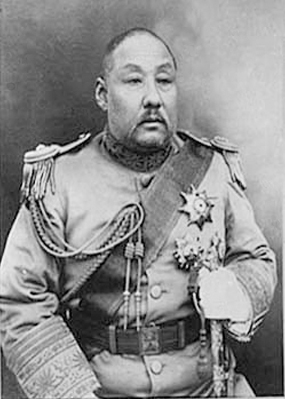
Huangshan is a prefecture-level city in southern Anhui Province, People's Republic of China. Huangshan means Yellow Mountain in Chinese and the city is named after the famously scenic Yellow Mountains which cover much of the city's vast geographic expanse. The prefectural city of Huangshan includes three urban districts and four counties. The urban center of Huangshan was originally the city of Tunxi and is now called Tunxi District. Locals still call the city Tunxi to distinguish the urban core from other parts of Huangshan. The population of Huangshan City As of the end of 2021, the resident population of Huangshan City was 1.332 million, with an urbanization rate of 59.25%, an increase of 0.96 percentage points over the previous year. By the end of 2021, the household population of Huangshan City will be 1,485,700, with an urbanization rate of 37.82%, an increase of 1.66 percentage points.
The Anhui clique was a military and political organization, one of several mutually hostile cliques or factions that split from the Beiyang clique in the Republic of China's Warlord Era. It was named after Anhui province because several of its generals–including its founder, Duan Qirui–were born in Anhui.
Eurymylidae is a family of extinct simplicidentates. Most authorities consider them to be basal to all modern rodents and may have been the ancestral stock whence the most recent common ancestor of all modern rodents arose. However, the more completely known eurymylids, including Eurymylus, Heomys, Matutinia, and Rhombomylus, appear to represent a monophyletic side branch not directly ancestral to rodents. Huang et al. (2004) have argued that Hanomys, Matutinia, and Rhombomylus form a clade characterized by distinctive features of the skull and dentition that should be recognized as a separate family, Rhombomylidae. Eurymylids are only known from Asia.

Zheng Yi Sao, also known as Shi Xianggu, Shek Yeung and Ching Shih, was a Chinese pirate leader active in the South China Sea from 1801 to 1810.

Zheng Xiaoyu was the director of the State Food and Drug Administration of the People's Republic of China from 2003 to 2005. He was sentenced to death for corruption and allowing possibly tainted products in mainland China in the first instance trial at Beijing No.1 Intermediate Court on May 29, 2007. He was executed on July 10, 2007.
The Politics of Anhui Province in the People's Republic of China is structured in a dual party-government system like all other governing institutions in mainland China.

Feidong County is a county of Anhui Province, East China, it is under the administration of the prefecture-level city of Hefei, the capital of Anhui. The county has a surface of 2,215.53 km2 (855.42 sq mi) and a population of 861,960 inhabitants. It contains 18 towns and 2 development zones.
Eoalligator is an extinct genus of alligatoroid crocodilian from Paleocene deposits in China.

Tillodontia is an extinct suborder of eutherian mammals known from the Early Paleocene to Late Eocene of China, the Late Paleocene to Middle Eocene of North America where they display their maximum species diversity, the Middle Eocene of Pakistan, and the Early Eocene of Europe. Leaving no descendants, they are most closely related to the pantodonts, another extinct group. The tillodonts were medium- to large-sized animals that probably fed on roots and tubers in temperate to subtropical habitats.
Anqingosaurus brevicephalus is an extinct lizard from the early Middle Paleocene of Anhui, China. A. brevicephalus was originally described as a chameleon, but, not all authorities agree with this. If A. brevicephalus is a chameleon, then Chamaeleonidae fossil record extends all the way into the Paleocene. If it is not, then Chamaeleonidae fossil record starts in the Early Miocene with Chamaeleo caroliquarti.

Zheng Shiqi, was a Chinese general, military governor of Shandong (1923–25) and Anhui (1925).

He Peirong was a military personnel and politician in the Republic of China. He belonged to the Beijing Government, Anhui clique. In the end, he was an important politician during the Reformed Government of the Republic of China and the Wang Jingwei regime. His courtesy name was Yunshan (韵珊). He was born in Jianshi, Hubei.
Wanosuchus is an extinct genus of sebecosuchian mesoeucrocodylian known from Paleocene-age rocks of southern Anhui, China. It is based on IVPP V 6262, a nearly complete lower jaw, which is also the only known specimen. The bone lacks an external mandibular fenestra and has thirteen teeth, the longest of which are the fourth and eleventh. It was collected between 1970 and 1972 by Institute of Vertebrate Paleontology and Paleoanthropology (IVPP) personnel; the exact location and rock unit that produced the bone are uncertain. Wanosuchus was named in 1981 by Zhang Fakui of the IVPP. The type species is W. atresus, a reference to the absent fenestra. Zhang classified Wanosuchus under its own family within Sebecosuchia, Wanosuchidae. It shares some characteristics with Doratodon, a crocodyliform from the Late Cretaceous of Europe.

Jinghai Temple is a 15th-century temple located in Nanjing, Jiangsu, China, to the southwest of Shizi Mountain. It was built to commemorate the voyage of Zheng He in the Ming Dynasty. The terms of the Treaty of Nanking were discussed in the temple. It was destroyed and rebuilt thrice, during the Taiping Rebellion and the Second Sino-Japanese War. In 1988, it was rebuilt on its original site. In 1990, the temple became home to the Historical Exhibition Museum of the Treaty of Nanking. After two expansions in 1996 and 2005, it is now the Nanjing Jinghai Temple Memorial, with material related to both Zheng He's voyage and the Treaty of Nanking. It is a National 4A Level Scenic Spot, as well as part of the National Patriotism Education Base, and the Nanjing Relic Protection Unit.

The Bachelor is a 2012 Chinese family television series produced by Yujia Shixing Pictures (御嘉世星影业).

The Three Heroes and Five Gallants is a 2016 Chinese television series produced by Huayi Brothers with Tianxing Yiyuan Entertainment (天星亿源影视), based on the 19th-century classic novel of the same name. Starring Chen Xiao, Yan Yikuan and Zheng Shuang, the series premiered on February 17, 2016, on Anhui TV.
Xu was an ancient Chinese state of the Zhou dynasty. In the early Western Zhou Dynasty, King Cheng of Zhou enfeoffed Xu Wenshu at Xu. The ruling family had the clan name of Jiang (姜), and the noble rank of baron (男).

Protoalligator is an extinct genus of alligatoroid crocodilian found in the Anhui province of China and lived during the Paleocene.
Hanma Technology Group Co., Ltd., formerly known as Hualing Xingma Automobile (Group) Co., Ltd. is a publicly traded Chinese manufacturer of trucks and truck-based special vehicles established in 1999. The company traces its origins back to a Ma'anshan manufacturer established in 1970. As a marque and as the company name in markets outside China, Hualing Xingma uses the designation CAMC. The current controlling shareholder of the company is Geely, who owns 28.01% through Geely New Energy Commercial Vehicle Group.

ZF2001, trade-named Zifivax or ZF-UZ-VAC-2001, is an adjuvanted protein subunit COVID-19 vaccine developed by Anhui Zhifei Longcom in collaboration with the Institute of Microbiology at the Chinese Academy of Sciences. The vaccine candidate is in Phase III trials with 29,000 participants in China, Ecuador, Malaysia, Pakistan, and Uzbekistan.














